
Digital Logic and Computer Design: M. Morris Mano 2nd
Edition


ISBN-10: 013140539X
ISBN-13: 978-0131405394
Author morris mano explains digital logic in most comprehensive way. Although the book is not user friendly author had covered enough topics to make it as standard text in colleges..
PS: The link is of second edition I have found and is scanned(I just say its readable)
Topics Covered:
Combinational Logic Design
Sequential Circuits
Registers and Counters
Memory and Programmable Logic Devices
Register Transfers and Datapaths
Sequencing and Control
Instruction Set Architecture
Central Processing Unit Designs
Input-Output and Communication
Memory Systems
Part 1 Part 2
ISBN-13: 978-0131405394
Author morris mano explains digital logic in most comprehensive way. Although the book is not user friendly author had covered enough topics to make it as standard text in colleges..
PS: The link is of second edition I have found and is scanned(I just say its readable)
Topics Covered:
Combinational Logic Design
Sequential Circuits
Registers and Counters
Memory and Programmable Logic Devices
Register Transfers and Datapaths
Sequencing and Control
Instruction Set Architecture
Central Processing Unit Designs
Input-Output and Communication
Memory Systems
Part 1 Part 2
Digital Signal Processing and Applications, Second Edition
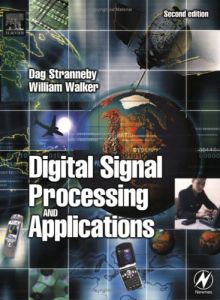
ISBN: 0750663448
368 pages | PDF | 1,9 Mb
A uniquely practical DSP text, this book gives a thorough understanding of the principles and applications of DSP with a minimum of mathematics, and provides the reader with an introduction to DSP applications in telecoms, control engineering and measurement and data analysis systems.
The new edition contains:
Expanded coverage of the basic concepts to aid understanding
New sections on filter sysnthesis, control theory and contemporary topics of speech and image recognition
Full solutions to all questions and exercises in the book
A complete on-line resource
The on-line resource offers instructors and students complete lecture notes, lecture videos, PowerPoint slides for presentations, final exams and solutions, project exercises, URLs to DSP applet experiment animations and e-meeting software for direct communication with the authors.
Assuming the reader already has some prior knowledge of signal theory, this textbook will be highly suitable for undergraduate and postgraduate students in electrical and electronic engineering taking introductory and advanced courses in DSP, as well as courses in communications and control systems engineering. It will also prove an invaluable introduction to DSP and its applications for the professional engineer.
· Expanded coverage of the basic concepts to aid understanding, along with a wide range of DSP applications
· New textbook features included throughout, including learning objectives, summary
sections, exercises and worked examples to increase accessibility of the text
· Full solutions to all questions and exercises included in the book, with extra resources on-line
368 pages | PDF | 1,9 Mb
A uniquely practical DSP text, this book gives a thorough understanding of the principles and applications of DSP with a minimum of mathematics, and provides the reader with an introduction to DSP applications in telecoms, control engineering and measurement and data analysis systems.
The new edition contains:
Expanded coverage of the basic concepts to aid understanding
New sections on filter sysnthesis, control theory and contemporary topics of speech and image recognition
Full solutions to all questions and exercises in the book
A complete on-line resource
The on-line resource offers instructors and students complete lecture notes, lecture videos, PowerPoint slides for presentations, final exams and solutions, project exercises, URLs to DSP applet experiment animations and e-meeting software for direct communication with the authors.
Assuming the reader already has some prior knowledge of signal theory, this textbook will be highly suitable for undergraduate and postgraduate students in electrical and electronic engineering taking introductory and advanced courses in DSP, as well as courses in communications and control systems engineering. It will also prove an invaluable introduction to DSP and its applications for the professional engineer.
· Expanded coverage of the basic concepts to aid understanding, along with a wide range of DSP applications
· New textbook features included throughout, including learning objectives, summary
sections, exercises and worked examples to increase accessibility of the text
· Full solutions to all questions and exercises included in the book, with extra resources on-line

Book Discription
Digital electronics is one of the fundamental courses found in all electrical engineering and most science programs. The great variety of LabVIEW Boolean and numeric controls/indicators, together with the wealth of programming structures and functions, make LabVIEW an excellent tool to visualize and demonstrate many of the fundamental concepts of digital electronics. The inherent modularity of LabVIEW is exploited in the same way that complex digital integrated circuits are built from circuits of less complexity, which in turn are built from fundamental gates. This manual is designed as a teaching resource to be used in the classroom as demonstrations, in tutorial sessions as collaborative studies, or in the laboratory as interactive exercises. The order of the labs follows most electronic textbooks.
The first six labs cover the fundamental circuits of gates, encoders, binary addition, D-latches, ring counters, and JK flip-flops. Many of the VIs are suitable for both classroom demonstration and laboratory exploration. The second set of six labs cover advanced topics such as DACs, ADCs, seven-segment displays, serial communication, and the CPU. These are best done in the context of a digital electronics lab, comparing the LabVIEW simulations with real integrated circuits. In each case, you can enhance simulations presented in the text by using a National Instruments DAQ board to interact with the real world through LabVIEW digital I/O, analog out, analog in, and serial VIs. Labs 2, 5, and 12 are application oriented and are designed to demonstrate encoding schemes, digital encryption, and the operation of a CPU. These labs could be presented as challenging problems in a tutorial setting or in a workshop environment.The labs can also be grouped to demonstrate special relationships ofadvanced devices on certain basic gates. For example, the CPU operation is dependent on the concept of registers and two input operations.
Fundamentals of Digital Electronics: Professor Barry
Paton

Chapter 1: NUMERATION SYSTEMS [ contents: Numbers
and symbols ~ Systems of numeration ~ Decimal versus binary numeration ~ Octal
and hexadecimal numeration ~ Octal and hexadecimal to decimal conversion ~
Conversion from decimal numeration ]
Chapter 2: BINARY ARITHMETIC [ contents: Numbers versus numeration ~ Binary addition ~ Negative binary numbers ~ Subtraction ~ Overflow ~ Bit groupings ]
Chapter 3: LOGIC GATES [ contents: Digital signals and gates ~ The NOT gate ~ The “buffer” gate ~ Multiple-input gates ~ TTL NAND and AND gates ~ TTL NOR and OR gates ~ CMOS gate circuitry ~ Special-output gates ~ Gate universality ~ Logic signal voltage levels ~ DIP gate packaging ~ Contributors ]
Chapter 4: SWITCHES [ contents: Switch types ~ Switch contact design ~ Contact “normal” state and make/break sequence ~ Contact “bounce” ]
Chapter 5: ELECTROMECHANICAL RELAYS [ contents: Relay construction ~ Contactors ~ Time-delay relays ~ Protective relays ~ Solid-state relays ]
Chapter 6: LADDER LOGIC [ contents: “Ladder” diagrams ~ Digital logic functions ~ Permissive and interlock circuits ~ Motor control circuits ~ Fail-safe design ~ Programmable logic controllers ~ Contributors ]
Chapter 7: BOOLEAN ALGEBRA [ contents: Introduction ~ Boolean arithmetic ~ Boolean algebraic identities ~ Boolean algebraic properties ~ Boolean rules for simplification ~ Circuit simplification examples ~ The Exclusive-OR function ~ DeMorgan’s Theorems ~ Converting truth tables into Boolean expressions ]
Chapter 8: KARNAUGH MAPPING [ contents: Introduction ~ Venn diagrams and sets ~ Boolean Relationships on Venn Diagrams ~ Making a Venn diagram look like a Karnaugh map ~ Karnaugh maps, truth tables, and Boolean expressions ~ Logic simplification with Karnaugh maps ~ Larger 4-variable Karnaugh maps ~ Minterm vs maxterm solution ~ (sum) and (product) notation ~ Don’t care cells in the Karnaugh map ~ Larger 5 & 6-variable Karnaugh maps ]
Chapter 9: COMBINATIONAL LOGIC FUNCTIONS [ contents: Introduction ~ A Half-Adder ~ A Full-Adder ~ Decoder ~ Encoder ~ Demultiplexers ~ Multiplexers ~ Using multiple combinational circuits ]
Chapter 10: MULTIVIBRATORS [ contents: Digital logic with feedback ~ The S-R latch ~ The gated S-R latch ~ The D latch ~ Edge-triggered latches: Flip-Flops ~ The J-K flip-flop ~ Asynchronous flip-flop inputs ~ Monostable multivibrators ]
Chapter 11: COUNTERS [ contents: Binary count sequence ~ Asynchronous counters ~ Synchronous counters ~ Counter modulus ]
Chapter 12: SHIFT REGISTERS [ contents: Introduction ~ Serial-in/serial-out shift register ~ Parallel-in, serial-out shift register ~ Serial-in, parallel-out shift register ~ Parallel-in, parallel-out, universal shift register ~ Ring counters ~ references ]
Chapter 13: DIGITAL-ANALOG CONVERSION [ contents: Introduction ~ The R/2nR DAC ~ The R/2R DAC ~ Flash ADC ~ Digital ramp ADC ~ Successive approximation ADC ~ Tracking ADC ~ Slope (integrating) ADC ~ Delta-Sigma () ADC ~ Practical considerations of ADC circuits ]
Chapter 14: DIGITAL COMMUNICATION [ contents: Introduction ~ Networks and busses ~ Data flow ~ Electrical signal types ~ Optical data communication ~ Network topology ~ Network protocols ~ Practical considerations ]
Chapter 15: DIGITAL STORAGE (MEMORY) [ contents: Why digital? ~ Digital memory terms and concepts ~ Modern nonmechanical memory ~ Historical, nonmechanical memory technologies ~ Read-only memory ~ Memory with moving parts: “Drives” ]
Chapter 16: PRINCIPLES OF DIGITAL COMPUTING [ contents: A binary adder ~ Look-up tables ~ Finite-state machines ~ Microprocessors ~ Microprocessor programming ]
Chapter 17: CONTRIBUTOR LIST [ contents: How to contribute to this book ~ Credits ]
Chapter 2: BINARY ARITHMETIC [ contents: Numbers versus numeration ~ Binary addition ~ Negative binary numbers ~ Subtraction ~ Overflow ~ Bit groupings ]
Chapter 3: LOGIC GATES [ contents: Digital signals and gates ~ The NOT gate ~ The “buffer” gate ~ Multiple-input gates ~ TTL NAND and AND gates ~ TTL NOR and OR gates ~ CMOS gate circuitry ~ Special-output gates ~ Gate universality ~ Logic signal voltage levels ~ DIP gate packaging ~ Contributors ]
Chapter 4: SWITCHES [ contents: Switch types ~ Switch contact design ~ Contact “normal” state and make/break sequence ~ Contact “bounce” ]
Chapter 5: ELECTROMECHANICAL RELAYS [ contents: Relay construction ~ Contactors ~ Time-delay relays ~ Protective relays ~ Solid-state relays ]
Chapter 6: LADDER LOGIC [ contents: “Ladder” diagrams ~ Digital logic functions ~ Permissive and interlock circuits ~ Motor control circuits ~ Fail-safe design ~ Programmable logic controllers ~ Contributors ]
Chapter 7: BOOLEAN ALGEBRA [ contents: Introduction ~ Boolean arithmetic ~ Boolean algebraic identities ~ Boolean algebraic properties ~ Boolean rules for simplification ~ Circuit simplification examples ~ The Exclusive-OR function ~ DeMorgan’s Theorems ~ Converting truth tables into Boolean expressions ]
Chapter 8: KARNAUGH MAPPING [ contents: Introduction ~ Venn diagrams and sets ~ Boolean Relationships on Venn Diagrams ~ Making a Venn diagram look like a Karnaugh map ~ Karnaugh maps, truth tables, and Boolean expressions ~ Logic simplification with Karnaugh maps ~ Larger 4-variable Karnaugh maps ~ Minterm vs maxterm solution ~ (sum) and (product) notation ~ Don’t care cells in the Karnaugh map ~ Larger 5 & 6-variable Karnaugh maps ]
Chapter 9: COMBINATIONAL LOGIC FUNCTIONS [ contents: Introduction ~ A Half-Adder ~ A Full-Adder ~ Decoder ~ Encoder ~ Demultiplexers ~ Multiplexers ~ Using multiple combinational circuits ]
Chapter 10: MULTIVIBRATORS [ contents: Digital logic with feedback ~ The S-R latch ~ The gated S-R latch ~ The D latch ~ Edge-triggered latches: Flip-Flops ~ The J-K flip-flop ~ Asynchronous flip-flop inputs ~ Monostable multivibrators ]
Chapter 11: COUNTERS [ contents: Binary count sequence ~ Asynchronous counters ~ Synchronous counters ~ Counter modulus ]
Chapter 12: SHIFT REGISTERS [ contents: Introduction ~ Serial-in/serial-out shift register ~ Parallel-in, serial-out shift register ~ Serial-in, parallel-out shift register ~ Parallel-in, parallel-out, universal shift register ~ Ring counters ~ references ]
Chapter 13: DIGITAL-ANALOG CONVERSION [ contents: Introduction ~ The R/2nR DAC ~ The R/2R DAC ~ Flash ADC ~ Digital ramp ADC ~ Successive approximation ADC ~ Tracking ADC ~ Slope (integrating) ADC ~ Delta-Sigma () ADC ~ Practical considerations of ADC circuits ]
Chapter 14: DIGITAL COMMUNICATION [ contents: Introduction ~ Networks and busses ~ Data flow ~ Electrical signal types ~ Optical data communication ~ Network topology ~ Network protocols ~ Practical considerations ]
Chapter 15: DIGITAL STORAGE (MEMORY) [ contents: Why digital? ~ Digital memory terms and concepts ~ Modern nonmechanical memory ~ Historical, nonmechanical memory technologies ~ Read-only memory ~ Memory with moving parts: “Drives” ]
Chapter 16: PRINCIPLES OF DIGITAL COMPUTING [ contents: A binary adder ~ Look-up tables ~ Finite-state machines ~ Microprocessors ~ Microprocessor programming ]
Chapter 17: CONTRIBUTOR LIST [ contents: How to contribute to this book ~ Credits ]
Lessons In Electric Circuits: DIGITAL BOOK
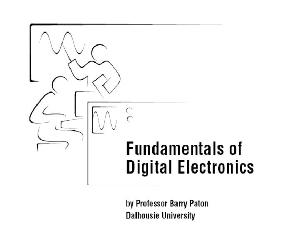
Digital
design Principles & Practices, john f. wakerly
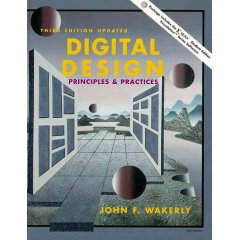

ISBN-10:
0131733494
Book Discription
Appropriate for a first or second course in digital logic design. This newly revised book blends academic precision and practical experience in an authoritative introduction to basic principles of digital design and practical requirements in both board-level and VLSI systems. With over twenty years of experience in both industrial and university settings, the author covers the most widespread logic design practices while building a solid foundation of theoretical and engineering principles for students to use as they go forward in this fast moving field.
Book Discription
Appropriate for a first or second course in digital logic design. This newly revised book blends academic precision and practical experience in an authoritative introduction to basic principles of digital design and practical requirements in both board-level and VLSI systems. With over twenty years of experience in both industrial and university settings, the author covers the most widespread logic design practices while building a solid foundation of theoretical and engineering principles for students to use as they go forward in this fast moving field.

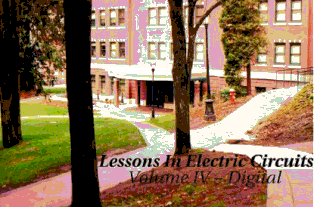

Complete
Digital Design
Hardcover:
460 pages
Publisher: McGraw-Hill Professional; METRC edition (June 18, 2003)
Language: English
ISBN-10: 0071409270
ISBN-13: 978-0071409278
Review
For engineers, students, and technicians or hobbyists concerned with real-world implementation of complete digital systems -- whether they involve a desktop computer or a car's engine controller -- electrical engineer Balch covers underlying concepts as well as the practicalities of design. He begins with digital logic and microprocessor fundamentals and then proceeds to more advanced topics (logic design methodologies, high-performance memory and networking technologies, and programmable logic devices); critical analog support circuitry; and design issues such as clock distribution, power regulation, signal integrity, design for test, and circuit fabrication techniques. (Sci-Tech Book News )
Book Info
Guide to understanding and navigating the interlocking components, architectures, and practices necessary to design and implement digital systems. Covers implementation of microprocessor-based digital systems, supporting analog circuit principles, and building complete systems with basic design elements and the latest technologies. For electrical engineers.
Publisher: McGraw-Hill Professional; METRC edition (June 18, 2003)
Language: English
ISBN-10: 0071409270
ISBN-13: 978-0071409278
Review
For engineers, students, and technicians or hobbyists concerned with real-world implementation of complete digital systems -- whether they involve a desktop computer or a car's engine controller -- electrical engineer Balch covers underlying concepts as well as the practicalities of design. He begins with digital logic and microprocessor fundamentals and then proceeds to more advanced topics (logic design methodologies, high-performance memory and networking technologies, and programmable logic devices); critical analog support circuitry; and design issues such as clock distribution, power regulation, signal integrity, design for test, and circuit fabrication techniques. (Sci-Tech Book News )
Book Info
Guide to understanding and navigating the interlocking components, architectures, and practices necessary to design and implement digital systems. Covers implementation of microprocessor-based digital systems, supporting analog circuit principles, and building complete systems with basic design elements and the latest technologies. For electrical engineers.
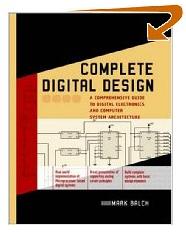

Digital Ebooks
This section
contains basic ebooks necessory for an electrical/electronics engineer.Choose ur
desired from the number of E-books.

Custom Search